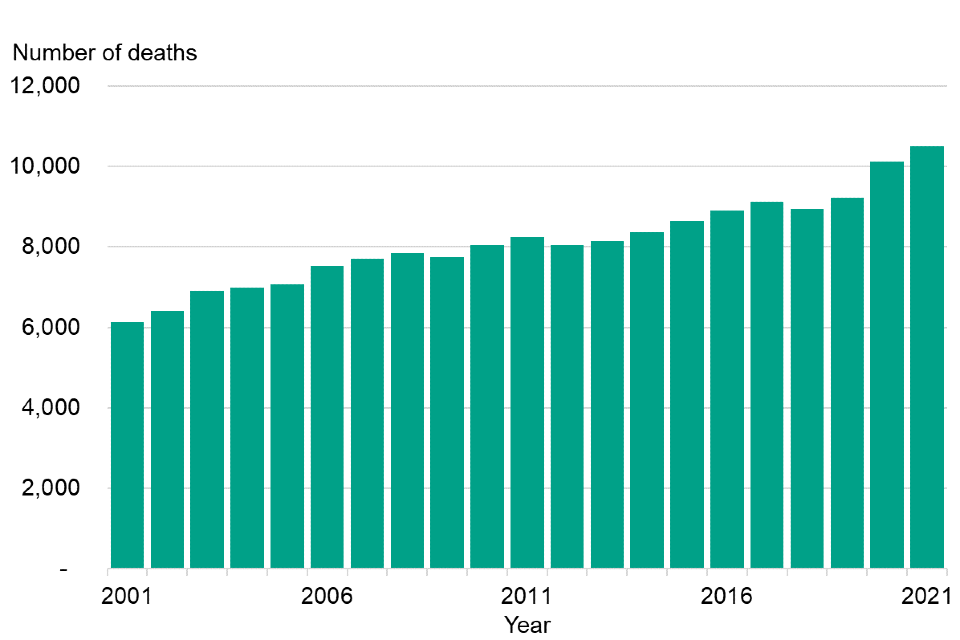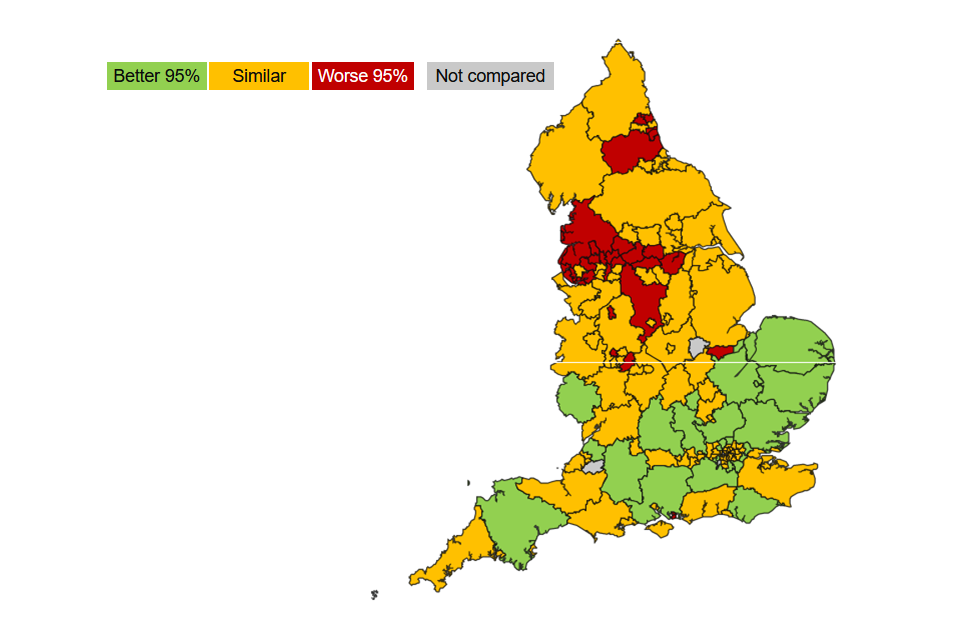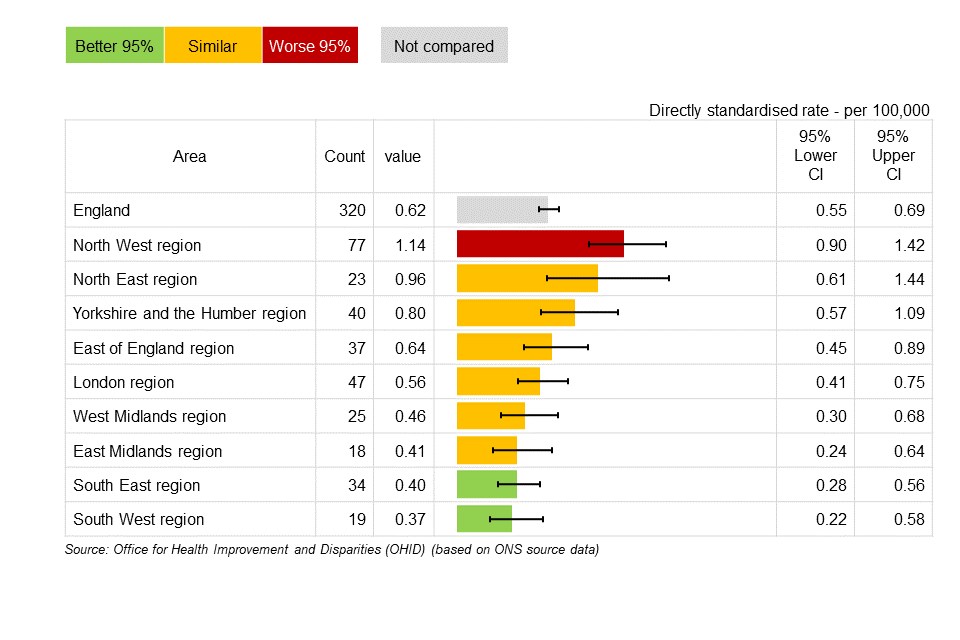Liver disease profiles, March 2023 update
Published 7 March 2023
Applies to England
New in this update
New 2021 mortality data has been added to the liver disease profile.
The liver profile from which this is a summary was developed by the national liver disease intelligence service following recommendations in March 2014 from the All-Party Parliamentary Hepatology Group (APPHG) inquiry into improving outcomes in liver disease chaired by the late Sir David Amess.
This update includes new data for 5 indicators in the liver disease profile:
- mortality from liver disease in persons, males and females aged under 75
- mortality from alcohol-related liver disease in persons, males and females aged under 75
- mortality from non-alcoholic fatty liver disease (NAFLD) in persons aged under 75
- mortality from hepatitis B related end-stage liver disease or hepatocellular carcinoma in persons aged under 75
- mortality from hepatitis C related end-stage liver disease or hepatocellular carcinoma in persons aged under 75
The definition of liver disease used in the profile includes primary liver cancer and uses the underlying cause of death field only so is likely to be an underestimate of the true number of premature deaths. It should also be noted that liver disease patients have multi-morbidities. The 2021 mortality indicators have been calculated using the new 2021 census-based populations. This is no longer comparable with previous data that was based on 2011 census-based populations. The back-series data has therefore been temporarily removed and will be recalculated as the rebased back-series population estimates become available.
Old data is available by request from liverdisease@dhsc.gov.uk or by clicking on the links within the indicator ‘definitions’ on the fingertips platform.
Main findings
This update shows:
- the number of premature deaths from liver disease rose by 3.7% in 2021 to 10,501 compared to 10,127 in 2020
- there has been a 63.6% increase in the number of premature deaths from liver disease in the past 20 years
- during 2021 there were 5,686 premature deaths from alcohol-related liver disease in England. This represents a 7.6% rise in number since the previous year when the figure was 5,285
- in the past 20 years the number of premature deaths from alcohol-related liver disease has increased by 74.2% in England
- in 2021 there were 320 premature deaths from non-alcoholic fatty liver disease in 2020 there was 330
- in 2021 there were 77 premature deaths from hepatitis B related end-stage liver disease or hepatocellular carcinoma, a rate of 0.15 (0.12 to 0.19) per 100,000 population aged under 75
- the number of premature deaths from hepatitis C in 2021 has plateaued in the last 3 years with numbers for 2021, 2020 and 2019 at 241, 237, 243 respectively
Summary
Premature mortality rate due to liver disease
This indicator presents data for 2021. Previous single year and 3-year data has been removed as it is no longer comparable with the new 2021 data. It is however available to download as a csv file. Back series data will be recalculated when the rebased population data is available. Data for this indicator is available for males, females and persons and for the geographies of England, region, UTLA, LTLA and ICB.
During 2021 there were 10,501 premature deaths due to liver disease in England, a rate of 21.2 (20.8 to 21.6) per 100,000 population aged under 75. This compares with 10,127 deaths in 2020.
This represents an increase of 374 premature deaths between 2020 and 2021 which is on top of the 909 deaths increase seen between 2019 and 2020.
Figure 1: number of deaths from liver disease in persons aged under 75, England, 2001 to 2021

In 2021 the number of premature deaths from liver disease for males was 6,577, and for females 3,924. Proportionally 62.6% were male and 37.4% female. These proportions have remained stable over the last 20 years.
Over 20 years, the number of premature deaths rose by 62.5% in males, and 65.4% in females.
Regionally, in 2021, the North West and North East had the highest rates of premature liver disease deaths across the country with respective rates of 29.3 (28.0 to 30.7) per 100,000 population aged under 75 and 28.8 (26.7 to 31.0) per 100,000 population aged under 75.
The North West region has the highest number (1,932) of deaths from premature liver disease. The South East has the second highest number (1,456) though it is the region with the lowest rate (17.5 per 100,000 population aged under 75).
Across England’s upper tier local authorities in 2021, Blackpool experienced the highest rates of premature liver disease deaths of 52.4 (40.7 to 66.2) per 100,000 population aged under 75. Sunderland, Oldham, Bolton and Rochdale were the next highest rates in the country. Richmond upon Thames had the lowest rate of 8.4 (4.8 to 13.7) per 100,000 population aged under 75.
In terms of counts, the upper tier local authority with the highest number of premature liver disease deaths was Lancashire 313 deaths, followed by Kent, Essex, Birmingham and Staffordshire. Richmond upon Thames had the lowest count of 16 deaths in those aged under 75.
Premature mortality due to alcohol-related liver disease
This indicator presents data for 2021. Previous single year and 3-year data has been removed as it is no longer comparable with the new 2021 data. It is however available to download as a csv file. Back series data will be recalculated when the rebased population data is available. The single year data is available for persons, and for England, region and UTLA geographies.
During 2021 there were 5,686 premature deaths from alcohol-related liver disease in England. This has risen by 401 deaths from 5,285 in 2020. This represents a 7.6% rise. The rate of premature deaths from alcohol-related liver disease was 11.5 (11.2 to 11.8) per 100,000 population aged under 75 in 2021. In contrast, in 2019 there were 4,459 deaths with an increase of 825.9 deaths (18.5%) between 2019 and 2020.
Since 2002 the number of premature deaths from alcohol-related liver disease has increased by 74.2% in England.
Rates of premature death from alcohol-related liver disease was significantly higher than England in the North East region 17.2 (15.6 to 18.9) per 100,000 population aged under 75, North West 16.5 (15.6 to 17.6), Yorkshire and the Humber 13.6 (12.6 to 14.7) and the West Midlands 13.4 (12.4 to 14.4). The North West region had the largest number 1,082 of premature death from alcohol-related liver disease, followed by South East with 756 deaths and West Midlands with 689 deaths.
Figure 2: under 75 mortality rate from alcoholic liver disease, region, 2021 (directly standardised rate per 100,000 population aged under 75)

Across the county and unitary authorities, rates varied from 3.1 (1.5 to 5.7) per 100,000 population aged under 75 and 10 deaths in Barnet to a rate of 29.8 (23.4 to 37.3) per 100,000 population aged under 75 with 76 deaths in Sunderland. Lancashire had the highest number of premature deaths from alcohol-related liver disease at 174.
Figure 3: map of under 75 mortality rate from alcoholic liver disease, region, 2021 (directly standardised rate per 100,000 population aged under 75) by county and UA level

Premature mortality due to non-alcoholic fatty liver disease
Due to the effects of COVID-19 on mortality data in 2020, single year data has been made available for this indicator, however numbers are small so figures should be treated with caution. Previous single year and 3-year data has been removed as it is no longer comparable with the new 2021 data. It is however available to download as a csv file. Back series data will be recalculated when the rebased population data is available. The single year data is available for persons, and for England and region geographies.
In 2021 there were 320 deaths, a rate of 0.60 (0.60 to 0.70) per 100,000 population aged under 75 compared to 2020 where there were 330 deaths.
Figure 4: under 75 mortality rate from non-alcoholic fatty liver disease, region, 2021 (directly standardised rate per 100,000 population aged under 75)

Premature mortality from hepatitis B related end-stage liver disease or hepatocellular carcinoma
Due to the effects of COVID-19 on mortality data in 2020, single year data has been made available for this indicator, however numbers are small so figures should be treated with caution. Previous single year and 3-year data has been removed as it is no longer comparable with the new 2021 data. It is however available to download as a csv file. Back series data will be recalculated when the rebased population data is available. The single year data is available for persons, and for England and region geographies.
In 2021 there were 77 premature deaths from hepatitis B related end-stage liver disease or hepatocellular carcinoma, a rate of 0.15 (0.12 to 0.19) per 100,000 population aged under 75 compared to 2020 where there were 82 deaths.
Premature mortality from hepatitis C related end-stage liver disease or hepatocellular carcinoma
Due to the effects of COVID-19 on mortality data in 2020, single year data has been made available for this indicator, however numbers are small so figures should be treated with caution. Previous single year and 3-year data has been removed as it is no longer comparable with the new 2021 data. It is however available to download as a csv file. Back series data will be recalculated when the rebased population data is available. The single year data is available for persons, and for England and region geographies.
About three-quarters of people infected with acute hepatitis C develop a chronic condition that can lead to end-stage liver disease or liver cancer. In 2016 the World Health Organization set a target to reduce hepatitis C mortality by 65% from the 2015 baseline by 2030. Since then, there has been increased treatment provision with direct-acting antiviral (DAA) drugs now available to patients.
In 2021, there were 241 deaths premature deaths from hepatitis C related end-stage liver disease or liver cancer, a rate of 0.47 (0.41 to 0.53) per 100,000 population aged under 75 compared to 2020 where there were 237 deaths.
Background and further information
Liver disease is almost entirely preventable with the major risk factors: alcohol, obesity and hepatitis B and C accounting for up to 90% of cases.
The liver disease profile provides an invaluable resource relating to one of the main causes of premature mortality nationally; a disease whose mortality rates are increasing in England, while decreasing in most EU countries. The local authority profiles will support the development of Joint Strategic Needs Assessments and the work of health and wellbeing boards presenting local key statistics and highlighting questions to ask locally about current action to prevent liver disease.
The website contains data for upper tier local authorities, former government office regions, England and, where available, lower tier local authorities and integrated care boards.
Further details about the profile methodology are available within the definitions section of the online version of the liver disease profile.
Responsible statistician, product lead: Liz Rolfe, Julia Verne.
For queries relating to this document, please contact: liverdisease@dhsc.gov.uk.
